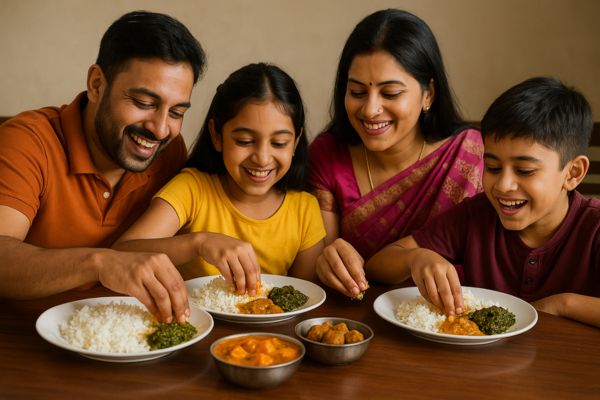
Rooted in the timeless wisdom of Indian heritage, eating with one's hands is more than a mere tradition, it's a practice deeply rooted in spirituality, mindfulness, and a profound connection to food. This age-old custom transcends generations, emphasizing the importance of engaging all senses during a meal.
Touching food with our hands is believed to foster a closer bond with what we consume, enhancing the dining experience. This tactile engagement not only heightens awareness of textures and temperatures but also signals the body to prepare for digestion, promoting better health outcomes.
Moreover, Ayurveda, the ancient Indian system of medicine, underscores the significance of eating with hands. Each finger is associated with one of the five elements, earth, water, fire, air, and space. And their union during eating is thought to harmonize these elements within the body, aiding in optimal digestion and balance.
In this article, we delve into the cultural, spiritual, and scientific facets of eating with hands, exploring its benefits and addressing common misconceptions.
Cultural Significance of Eating with Hands
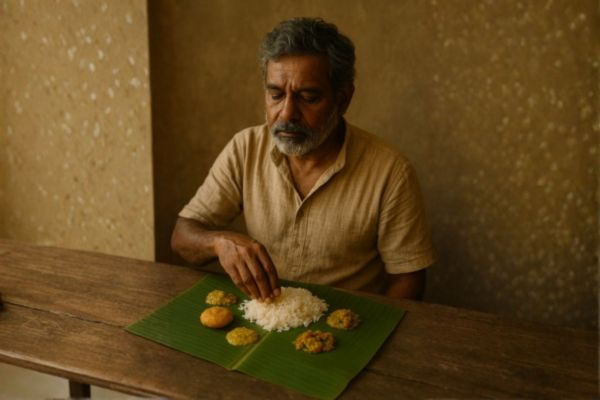
In Indian culture, eating with one's hands is more than a method of consumption; it's a practice steeped in tradition, spirituality, and communal values. This age-old custom reflects a deep connection between food, the body, and the environment, emphasizing mindfulness and respect.
A Tradition Rooted in History

The practice of eating with hands dates back to ancient times, with references found in scriptures like the Vedas and Upanishads. It was believed that using hands to eat fostered a closer bond with the food, enhancing the dining experience through the engagement of all senses.
Spiritual Connection Through Touch

In Ayurveda, each finger is associated with one of the five elements: earth, water, fire, air, and space. Using all fingers to eat is thought to balance these elements within the body, promoting better health and digestion. indiasflavour.com
Communal Harmony and Togetherness
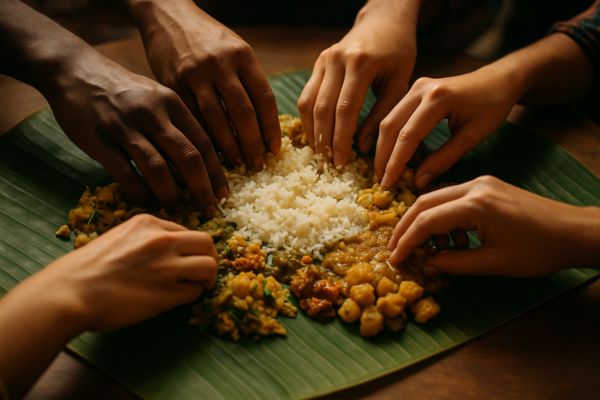
Eating with hands often involves sharing food from a common plate, symbolizing unity and equality. This communal aspect reinforces social bonds and reflects the Indian value of 'Atithi Devo Bhava', treating guests as gods.
Mindful Eating and Gratitude
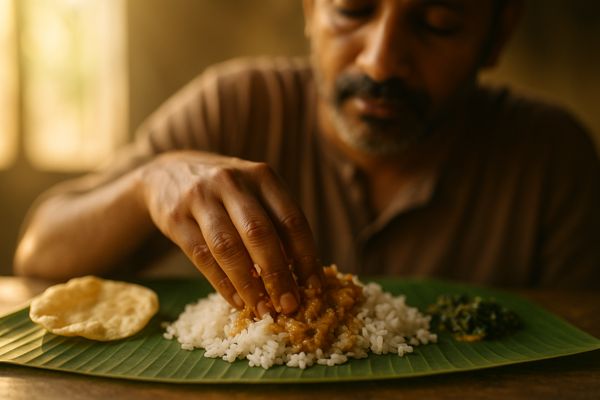
The tactile experience of eating with hands encourages mindfulness, allowing individuals to be fully present during meals. This practice fosters gratitude for the food and the effort involved in its preparation, aligning with the cultural emphasis on humility and appreciation.
The Spiritual Aspect; Mindfulness in Eating

In Hinduism and yogic philosophy, eating is not just a physical act, it is a sacred ritual. The way we approach food reveals the state of our inner world. When we eat with our hands, we naturally slow down, become present, and engage fully with the experience. This is mindfulness in action, and it is deeply spiritual.
Food as Prasad, Not Just a Meal

In many Indian households, food is offered to the divine before it is eaten. Whether it’s a simple home-cooked meal or a festive feast, the plate becomes prasad—sanctified nourishment. Eating with hands in such a context is seen as an act of humility and devotion, connecting the eater directly with what is sacred.
The Gesture of Gratitude
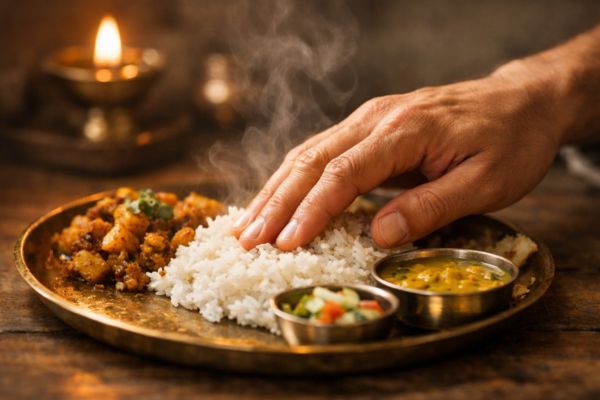
Touching the food before it enters the mouth allows the individual to acknowledge its texture, warmth, and energy. This fosters a sense of thankfulness, making one aware of:
- Where the food came from
- Who prepared it
- How it nourishes both body and soul
This subtle awareness transforms eating into a form of offering (yajna), where the body is the temple, and digestion is the sacred fire.
An Extension of Yogic Awareness
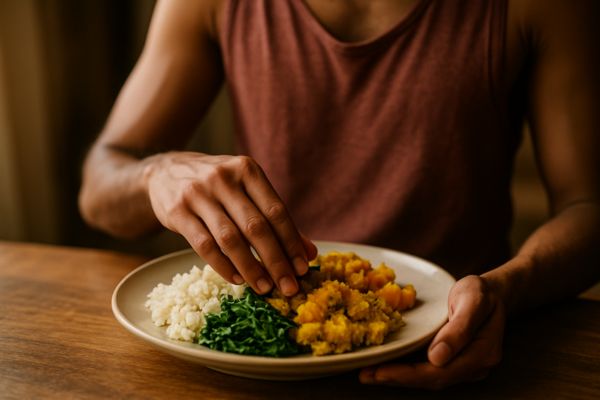
In yogic practices, the body is a vehicle of awareness. Eating with one’s hands brings consciousness to every bite. It awakens the senses of touch, smell, and taste, promoting a more centred and peaceful state. This kind of intentional eating aligns with Sattva, the guna of clarity, balance, and harmony.
Engaging the Five Elements
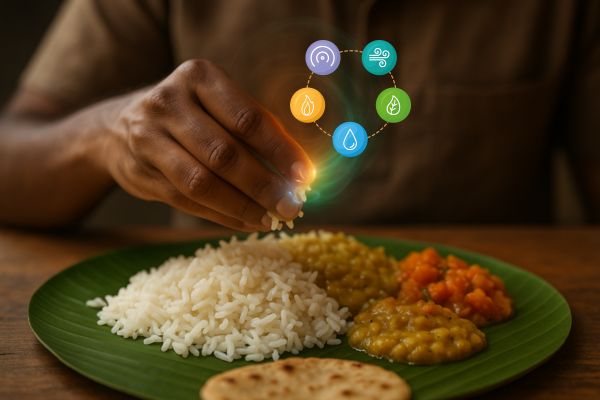
When all fingers come together to gather food, it is said to activate digestive fire and restore elemental balance. Thus, the act of eating becomes a subtle spiritual practice one that integrates body, mind, and nature.
Eating with hands teaches us to slow down, savour, and honour the sacred in the ordinary.
Scientific and Ayurvedic Benefits
Eating with hands may appear old-fashioned in a modern dining context, but both science and Ayurveda reveal that this age-old practice offers profound physiological and energetic benefits. Far from being a matter of mere tradition, it aligns the act of eating with digestive readiness, body awareness, and elemental balance.
Hands Have Nerve Endings That Stimulate Digestion
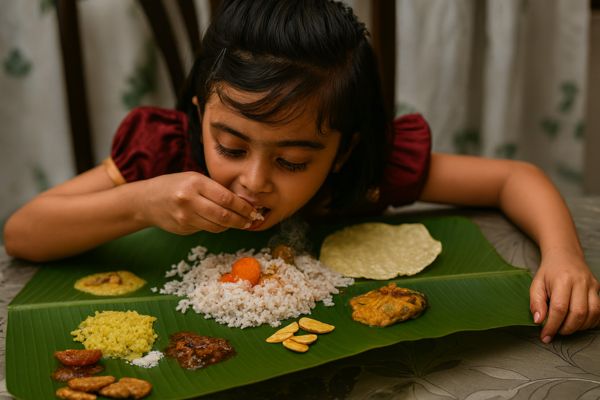
The fingertips are rich with nerve endings that are connected to the digestive system and brain. When your fingers come into contact with food, these nerve endings send signals to your brain, priming your system to release the right digestive juices even before you take the first bite.
This tactile awareness prepares the body to digest and assimilate food efficiently. It’s not just about taste; it’s about creating a sensory and nervous system connection with your food.
Signals Brain to Prepare Enzymes Through Touch
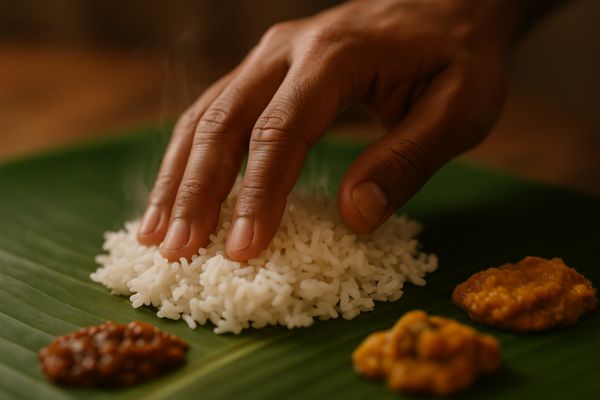
Modern science acknowledges the cephalic phase of digestion, which is initiated by sight, smell, and touch. Touching your food:
Activates enzymatic secretions in the stomach and mouth
Promotes mindful eating, slowing you down to chew and absorb better
Enhances the gut-brain communication, supporting better metabolic function
Ayurveda complements this view by asserting that conscious contact with food energizes agni (digestive fire), which governs digestion, transformation, and nourishment.
Balanced Posture and Portion Control

Eating with hands, especially in a cross-legged or seated position on the floor, naturally aligns the spine and promotes conscious portion control. You’re more aware of:
How much you’re picking up
The temperature and texture of food
The rhythm of chewing and swallowing
This awareness discourages overeating, supports satiety, and nurtures a calm digestive environment.
Ayurveda and the Five Fingers: The Panchabhootas

In Ayurveda, each finger represents one of the five elements (Pancha Mahabhutas):
Thumb – Agni (Fire)
Forefinger – Vayu (Air)
Middle finger – Akash (Space)
Ring finger – Prithvi (Earth)
Little finger – Jala (Water)
When you gather food with all five fingers and bring it to your mouth, you're believed to be activating and harmonizing all five elements within you, ensuring balanced digestion and energy.
In both science and Ayurveda, eating with hands is not primitive, it is intelligent. It respects the body’s sensory design, digestive intelligence, and natural rhythm.
Hygiene and Modern Concerns

In today’s fast-paced, urban lifestyles, the idea of eating with hands may raise questions around cleanliness. However, this concern often stems from a surface-level understanding. In truth, Indian traditions surrounding food are deeply rooted in hygiene, self-awareness, and sacredness. The act of eating with hands is not careless, it’s conscious, clean, and connected.
Myth: Eating With Hands Is Unhygienic (Truth: It’s About Cleanliness)
_201753.jpg)
A common misconception surrounding the practice of eating with hands is that it is unsanitary or outdated. However, hygiene is not determined by the method of eating, but by the cleanliness of the hands themselves. In fact, eating with one's own hands can be more hygienic than using shared cutlery in public or poorly washed utensils.
The key lies in intentional cleanliness. A value deeply ingrained in Indian culture. Before every meal, washing hands thoroughly with soap is a ritual, not an afterthought. Unlike spoons or forks that might carry residues or get reused in communal settings, your hands are under your control, ensuring better personal hygiene when properly maintained.
Moreover, recent studies show that our skin contains healthy microbiota that aid in digestion and immune response. Eating with clean hands supports this natural interaction, while over-sterilized tools may disrupt it.
Handwashing Rituals in Indian Households

Indian households traditionally follow a simple yet sacred hygiene practice before every meal: wash hands, mouth, and feet (if eating on the floor). This isn’t just about physical purity. It’s symbolic of mental preparation and respect for the food being consumed.
In many homes, even today, children are taught from a young age:
- To never touch food without washing hands
- To avoid licking fingers or being messy while eating
- To clean their plate completely as a mark of gratitude
Some families even chant a small mantra or offer silent prayers before meals, turning the act of handwashing into a mindful ritual, cleansing both body and intent.
Comparison With Other Cultures

The way we eat reflects our culture, values, and relationship with food. Around the world, eating practices vary greatly, each shaped by historical, environmental, and spiritual factors.
In many Western cultures, the use of forks, knives, and spoons is seen as a sign of etiquette. Meals are often structured, with a strong focus on table manners and formal dining. However, this separation between hands and food may create a degree of detachment from the meal itself, reducing sensory engagement.
In contrast, East Asian traditions like those in Japan or China emphasize the use of chopsticks. These utensils, while delicate and precise, also encourage mindful eating through small portions and slow consumption, values that align with the Indian practice of eating slowly and consciously.
Indian dining, especially when done with hands, invites a deeper connection to food. It engages touch, texture, and temperature, senses that are often bypassed when using tools. It fosters mindfulness and a sense of reverence, especially when food is seen as prasad or divine nourishment.
Even in African cultures, Middle Eastern traditions, and some Southeast Asian communities, eating with hands is considered natural, communal, and grounding. Sharing food from a common plate, eating in circles, or sitting on the floor are all expressions of hospitality, unity, and humility, values echoed in Indian customs as well.
Ultimately, while tools may vary, the deeper intention behind food rituals gratitude, connection, and nourishment remains universal.


-in-Astrology.jpg)






.jpg)



Comments 0
Leave your thought here